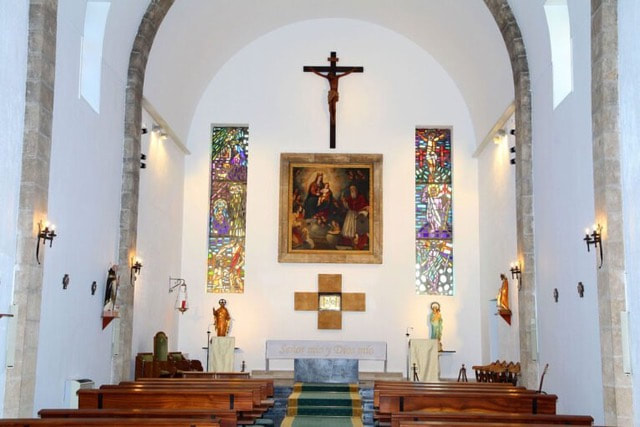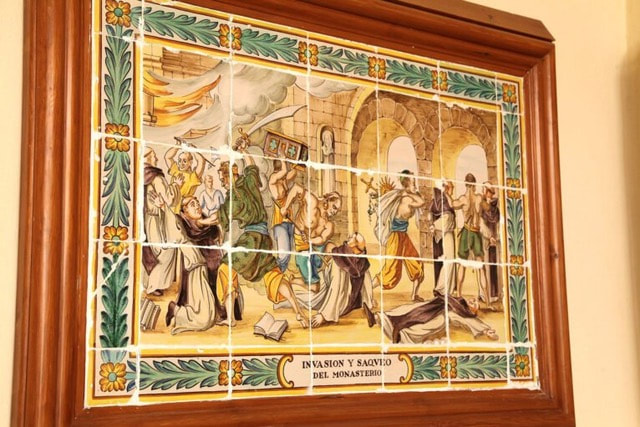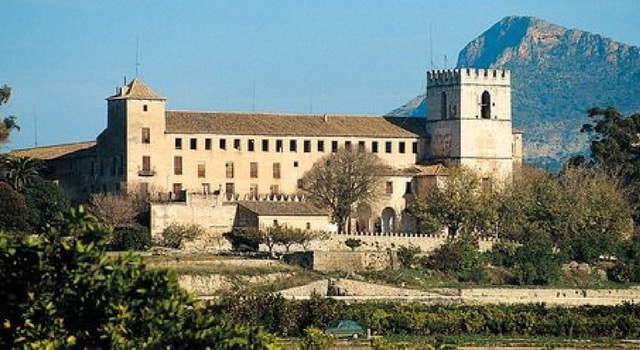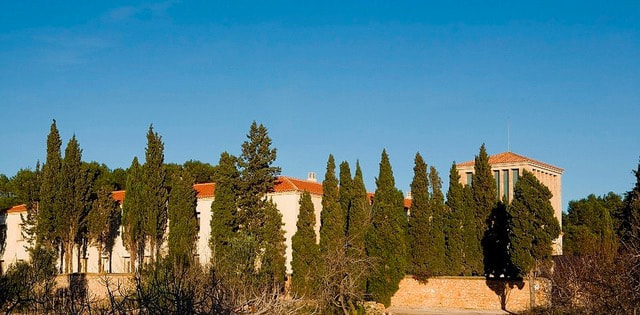|
In the Middle Ages, this area attracted many hermits who were inspired by it for meditation and devotion to God.
Towards mid 14th century the ascetic and erudite St. Jerome became very popular. St. Jerome (b. ca. 347 in Dalmatia, d. ca. 419 in Bethlehem) , who was a scholar and translator of the Bible from Greek and Hebrew into Latin, lived for several years as a hermit and was founder of a Hieronymite monastery and convent in Bethlehem. Inspired by St. Jerome, many Hieronymites came as hermits to the seclusion of the Plana and lived in the many caves on the lower part of the Cabo San Antonio. They became well-known for their piety and self-abnegation and many would come from far and wide to pay them their respects. These caves are still called Coves Santes (holy caves), as they have been called for centuries because of these hermits. The hermits would come together from time to time to discuss fundaments of their belief and in 1374 they decided to ask the Pope for permission to found a monastery on the Plana. Three of the hermits then journeyed to Avignon, seat of Pope Gregory XI and returned with a papal bull, granting them their wish. The same year, construction of a small, very elementary monastery began. It was finished in only eleven months. It was mainly financed by their patron, the royal Duke Alfonso of Aragon, Alfons el Vell, Duke of Gandia, Marquis of Denia and grandson of King Jaime II. In 1375 the twelve hermits moved from their caves to the monastery, with Friar Jaime Ibañez as their prior. It was the first Hieronymite monastery in Spain. Here they lived in silence, praying and meditating. They lived in utter poverty, sometimes working in the fields for subsistence, sometimes begging, which the Pope had permitted them to do. In those days, Xabea, as it was called, was often plagued by Berber pirate attacks. In 1386 even this poverty-stricken monastery was not spared. A band of pirates entered and brutally harassed the monks, taking nine of them as hostages, one of whom died on the way down to the port. They were taken to Algiers and Bugia, today in Algeria. The Duke paid a huge ransom to set them free and they were returned to Xabea in 1392. After the attack they never felt safe again here. Duke Alfonso also feared for their safety, so in 1388 he bought the territories of Cotalba, 8 kms inland from Gandia from the Muslim owner, and donated them for the construction of a new, larger monastery. In that very year the construction works began, planned and overseen by the Duke´s own mayordomo (chief administrator) Pere March, father of the famous poet Ausias March (later, several members of the March family would be buried in a chapel of the church). In the following year, the monks moved into the Monastery of St. Jerome of Cotalba. This beautiful albeit simple monastery is today one of the most historic monastic constructions in the Comunidad Valenciana. It is no longer a monastery (since 1835), but has been conserved in the original state for tourist visits. The original Monastery of St. Jerome of the Plana remained abandoned for several centuries until towards end of the 17th century, when, legend has it, a hunter found a canvas in a tree on the monastery grounds representing the Virgin Mary surrounded by angels, with Jesus on her lap and St. Jerome nearby. This „miracle“ finding prompted the reopening of the monastery and the veneration of the Virgin of the Angels. The monastery, despite renovations and remodelling works after pillages and wars, maintained its original 14th century features until 1962 when unfortunately a massive refurbishment was undertaken, and most of the original features were destroyed. In 1994 certain elements were salvaged and returned to their original state. Today it is called the Sanctuari de la Mare de Déu dels Àngels (Hermitage of Our Lady of the Angels) and is run by nuns, Daughters of St. Mary of the Sacred Heart of Jesus. Every year the fiesta of the Plana (usually from 1st-3rd August) commemorates the re-founding of the hermitage in a procession with the residents of the Plana, where the original 17th century painting is carried around the grounds of the hermitage and a Mass is held. The canvas then returns to the church of the hermitage as its central alter piece. In the courtyard of the hermitage there is also a series of ceramic tile paintings depicting varoius episodes of the founding of the original monastery. There is access to this part of the hermitage on most days. The Hermitage is not open for tourist visits but anyone can join Mass held daily at 9am in the church where the canvas painting is housed. On Sundays and holidays mass is held at 10am and again at 19.00.
0 Comments
|
ACTIVITIES
Categories |
- Home
- Blogs
-
Projectes
- Premio de Investigación - Formularios de Inscripción
-
Traducciones Translations
>
-
DISPLAY PANELS - GROUND FLOOR
>
- THE STONE AGES - PALAEOLITHIC, EPIPALAEOLITHIC AND NEOLITHIC
- CAVE PAINTINGS (ARTE RUPESTRE)
- CHALCOLITHIC (Copper) & BRONZE AGES
- THE IBERIAN CULTURE (THE IRON AGE)
- THE IBERIAN TREASURE OF XÀBIA
- THE ROMAN SETTLEMENTS OF XÀBIA
- THE ROMAN SITE AT PUNTA DE L'ARENAL
- THE MUNTANYAR NECROPOLIS
- ARCHITECTURAL DECORATIONS OF THE PUNTA DE L'ARENAL
- THE ATZÚBIA SITE
- THE MINYANA SMITHY
- Translations archive
- Quaderns: Versión castellana >
- Quaderns: English versions >
-
DISPLAY PANELS - GROUND FLOOR
>
- Catálogo de castillos regionales >
- Exposició - Castells Andalusins >
- Exposición - Castillos Andalusíes >
- Exhibition - Islamic castles >
- Sylvia A. Schofield - Libros donados
- Mejorar la entrada/improve the entrance >
-
Historia y enlaces
-
Historía de Xàbia
>
- Els papers de l'arxiu, Xàbia / los papeles del archivo
- La Cova del Barranc del Migdia
- El Vell Cementeri de Xàbia
- El Torpedinament del Vapor Germanine
- El Saladar i les Salines
- La Telegrafía y la Casa de Cable
- Pescadores de Xàbia
- La Caseta de Biot
- Castell de la Granadella
- La Guerra Civil / the Spanish civil war >
- History of Xàbia (English articles) >
- Charlas y excursiones / talks and excursions >
- Investigacions del museu - Museum investigations
- Enllaços
- Enlaces
- Links
-
Historía de Xàbia
>
- Social media
- Visitas virtuales
- Tenda Tienda Shop









 RSS Feed
RSS Feed
